This is one in a series of posts on the Fujifilm GFX 100S. You should be able to find all the posts about that camera in the Category List on the right sidebar, below the Articles widget. There’s a drop-down menu there that you can use to get to all the posts in this series; just look for “GFX 100S”. Since it’s more about the lenses than the camera, I’m also tagging it with the other Fuji GFX tags.
I’ve been posting a lot recently about the 120 mm f/4 GF macro lens for the GFX. I found it a good performer at 1:2, at minimum focusing distance (MFD) with no extension tubes, but that it had really soft edges and a lot of focus curvature at MFD with 36 mm of tubes. In this post, I tested it at 1:1 with a 45 mm tube,a and found it credible on-axis but soft on the right edge of the frame. I reported those results numerically and visually, using the time honored sharpness target of a banknote. The 120/4 GF was soft in the corners and edges at MFD with 18mm, 36mm, and 45mm of extension by tubes.
For copy applications, and for some 3D subjects that require extension tubes, the 120/4 GF just isn’t cutting it. I tried the CV 125/2.5 and it was a big improvement. I’d tried a Schneider 90 mm f/4.5 Apo Componon enlarging lens, and it was a disappointment at 1:1. I’d heard good things about the Pentax 645 120mm f/4 smc FA macro lens. It focuses to 1:1 natively, so I thought it might do better at 1:1 than the native GFX 120/4 macro, which needs a 45 mm tube to get to 1:1, and suffers off-axis when extended.
I adapted the Pentax lens to the GFX with a Cambo Actus.
A simple dumb adapter would have worked as well, but I had the Cambo set up already, and just needed to change lens boards
Here’s the test procedure:
- GFX 100S
- Foba camera stand
- C1 head
- Cambo Actus
- Lens focused to get to 1:1 magnification
- ISO 100
- Electronic shutter
- 10-second self timer
- Indicated f/4 through f/11 in whole-stop steps
- Exposure time adjusted in M mode
- Cognisys rail 100 exposures, 40 um step size
- Initial focus short of target
- Convert RAF to DNG using Adobe DNG Converter
- Extract raw mosaics with dcraw
- Extract slanted edge for each raw plane in a Matlab program the Jack Hogan originally wrote, and that I’ve been modifying for years.
- Analyze the slanted edges and produce MTF curves using MTF Mapper (great program; thanks, Frans)
- Fit curves to the MTF Mapper MTF50 values in Matlab
- Correct for systematic GFX focus bracketing inconsistencies
- Analyze and graph in Matlab
The results:
The vertical axis is MTF50 in cycles per picture height. Higher is sharper. The horizontal axis is f-stop.
- The blue and red columns are for the Pentax lens on axis, with, respectively, a horizontal and a vertical edge.
- The yellow and purple columns are for the Fuji 120/4 macro lens on axis, with, respectively, a horizontal and a vertical edge.
- The green and light blue columns are for the Pentax lens on the right side of the 33×44 mm frame, with, respectively, a horizontal and a vertical edge.
- The brick red and blue columns are for the Fuji 120/4 macro lens on the right side of the 33×44 mm frame, with, respectively, a horizontal and a vertical edge.
Indicated f/8 gives the best compromise performance for both lenses. At f/8, the Fuji lens is slightly sharper in the center, and quite a bit weaker at the edge.
Looking at micro contrast, which I’m defining for this post as contrast at 0.25 cycles per pixel.
Again, f/8 indicated is the best compromise stop, and the Fuji lens is better on axis and worse off axis.
Comparing the Pentax lens to the CV 125mm f/2.5 Apo Lanthar:
At indicated f/8, the CV is a hair better, but there’s really not that much difference between the two lenses. This is good news, since the Pentax lens is =much cheaper and d=easier to find than the CV.
We can look at on-axis MTF50 versus defocus distance for each of the raw channels to get an idea of longitudinal chromatic aberration (LoCA).
At the right edge, for horizontal edges:
And, finally, a lot at the point spread function cross-section at f/8 on axis:
Subject distance runs from top to bottom, with the top being front-focused, and the bottom being back-focused.
At the edge for a horizontal (radial) edge:
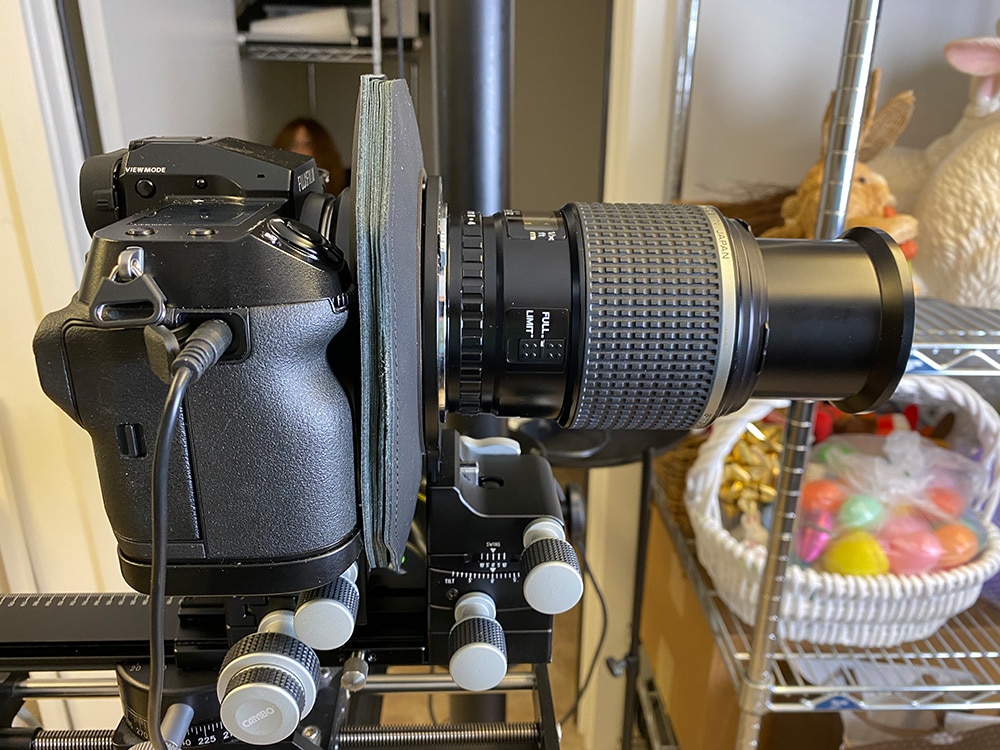
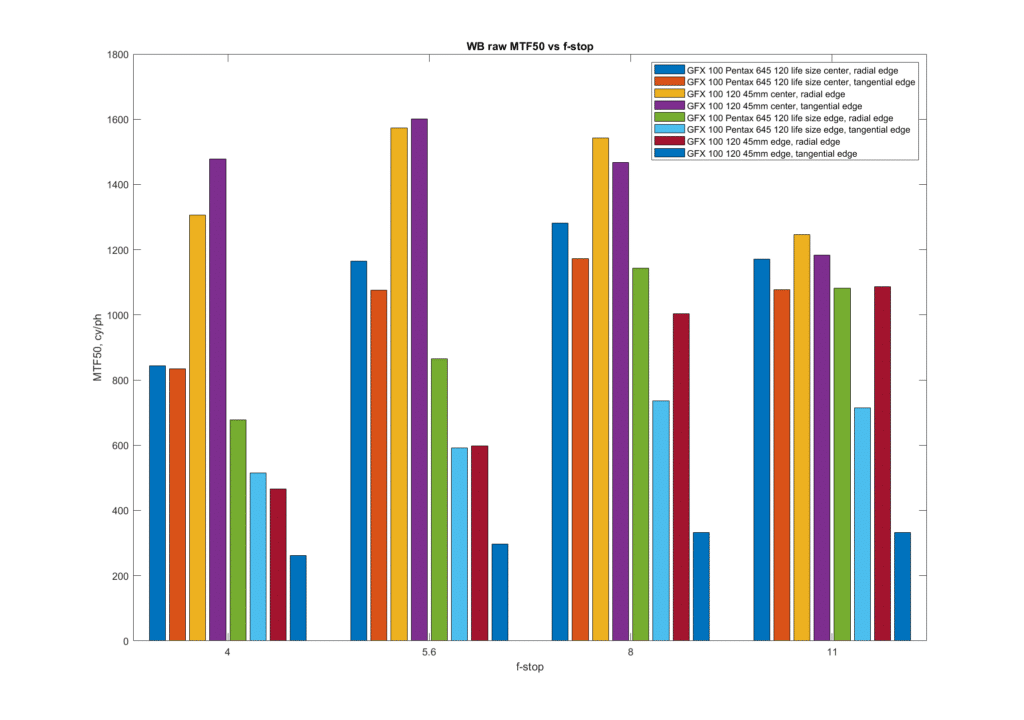
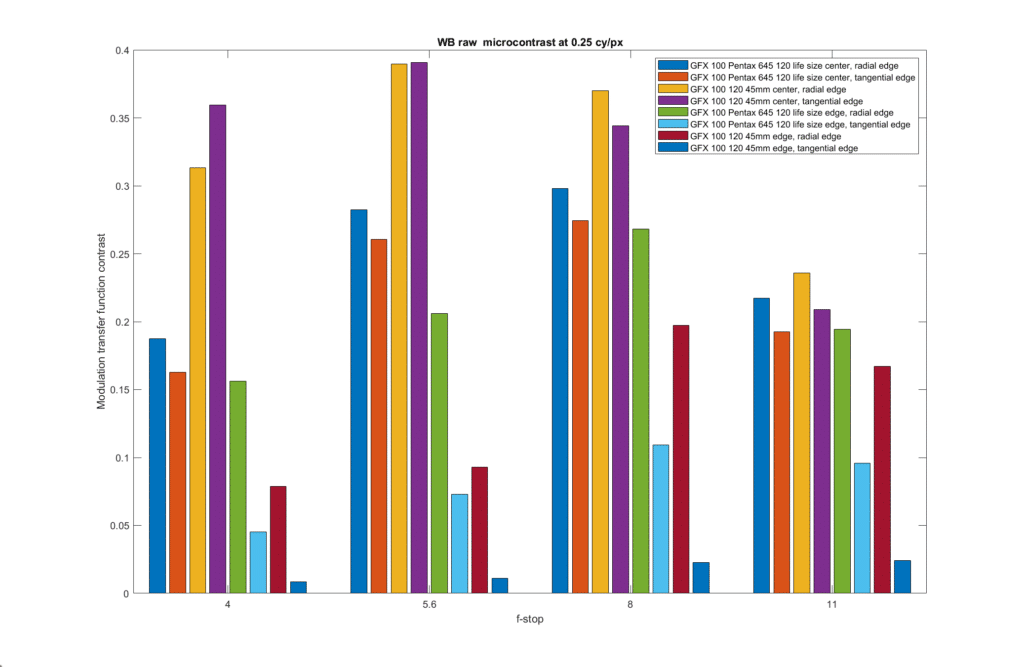
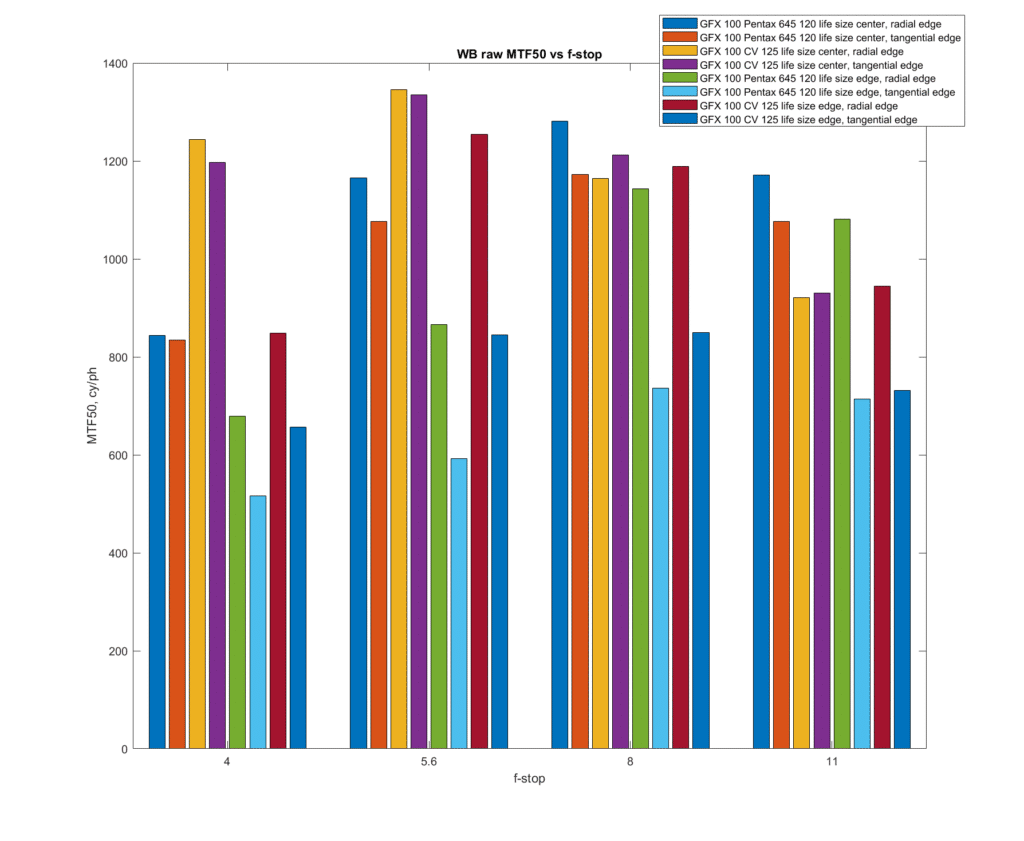
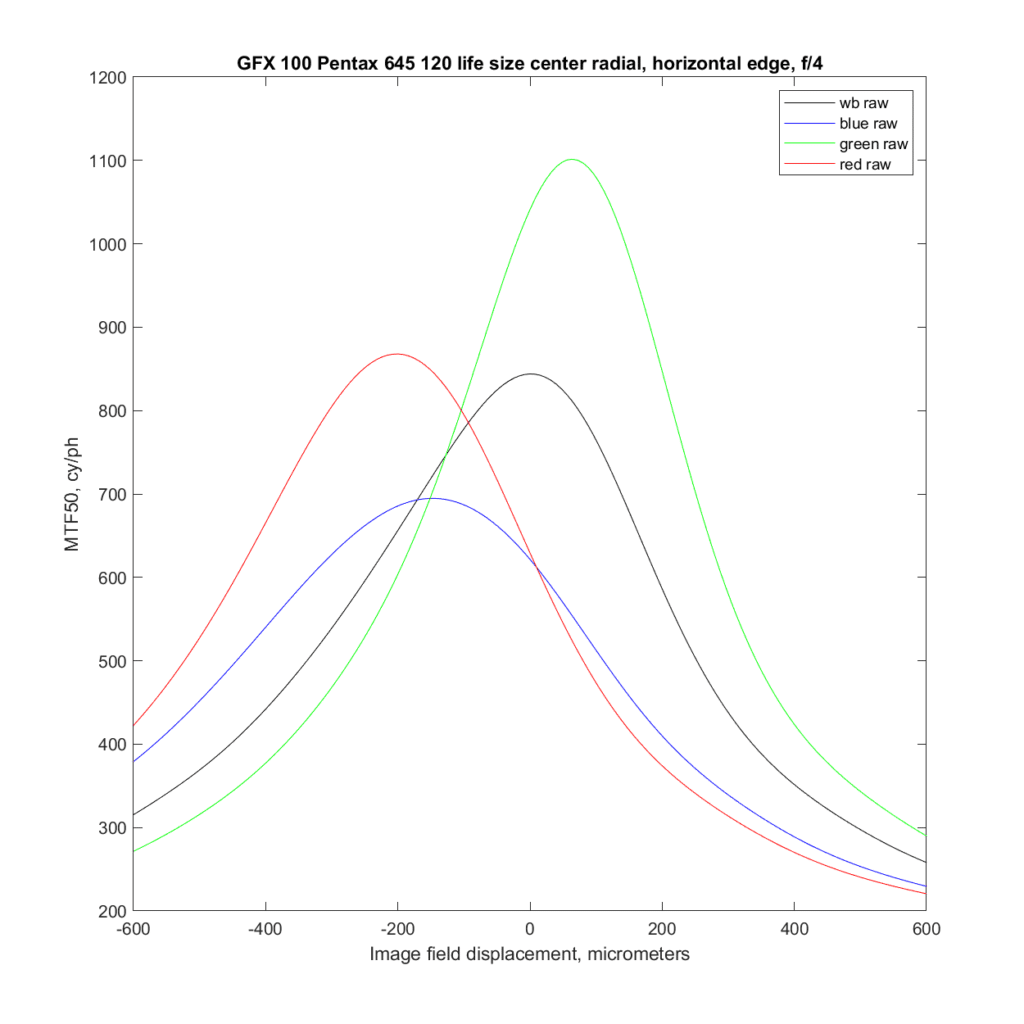
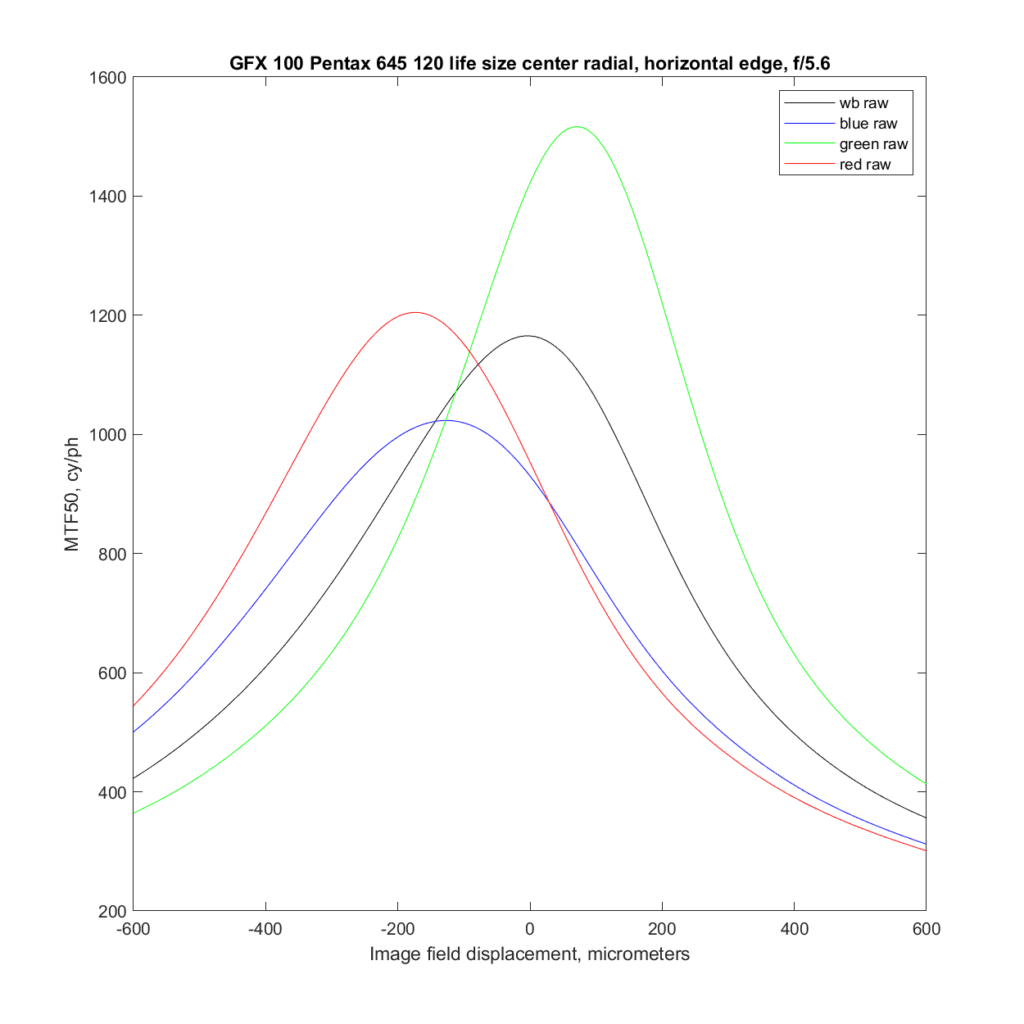
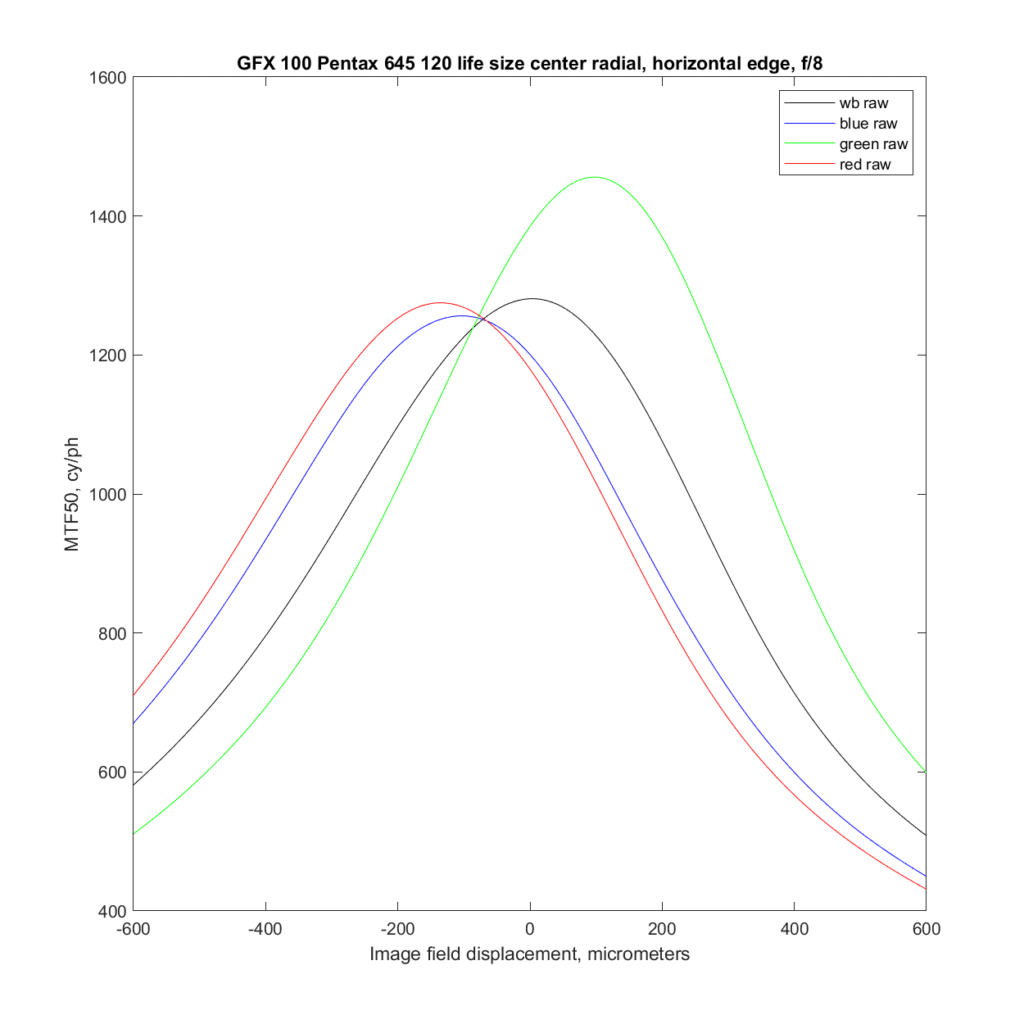
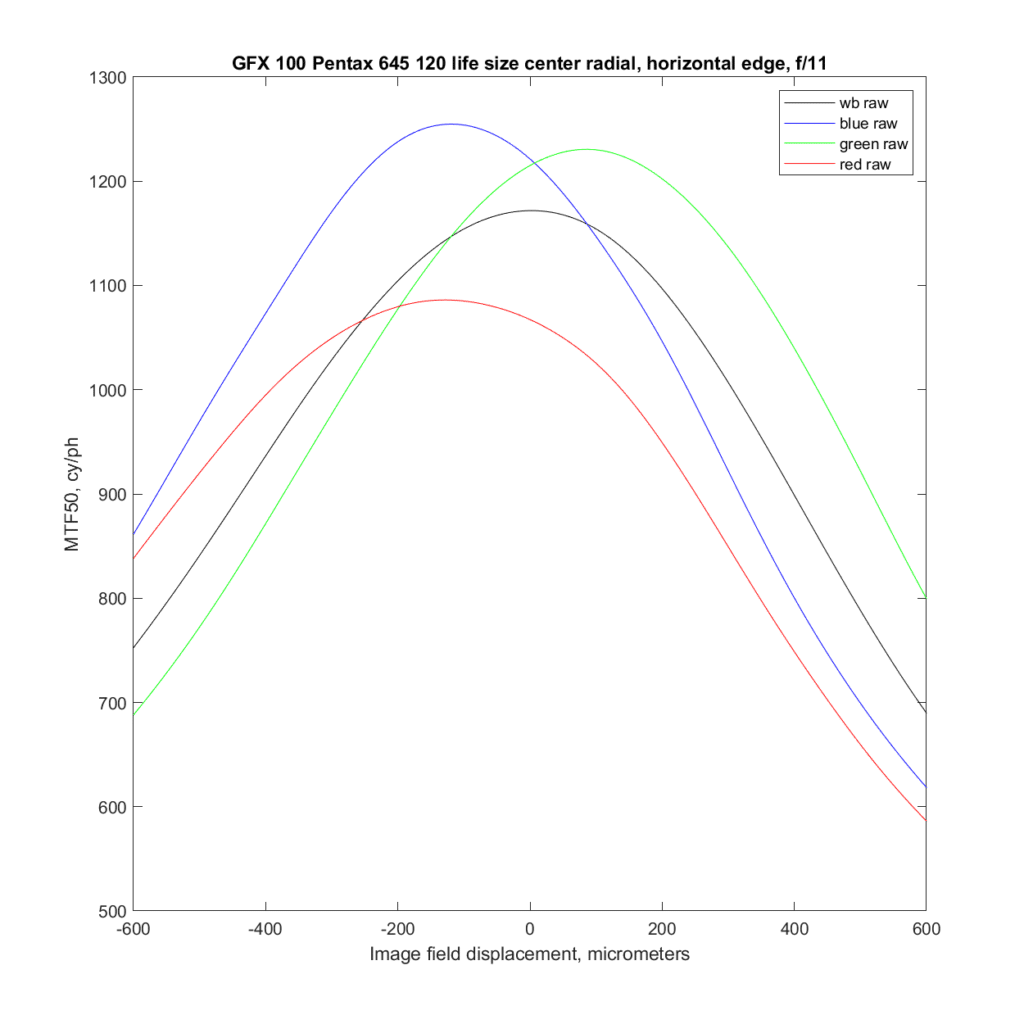
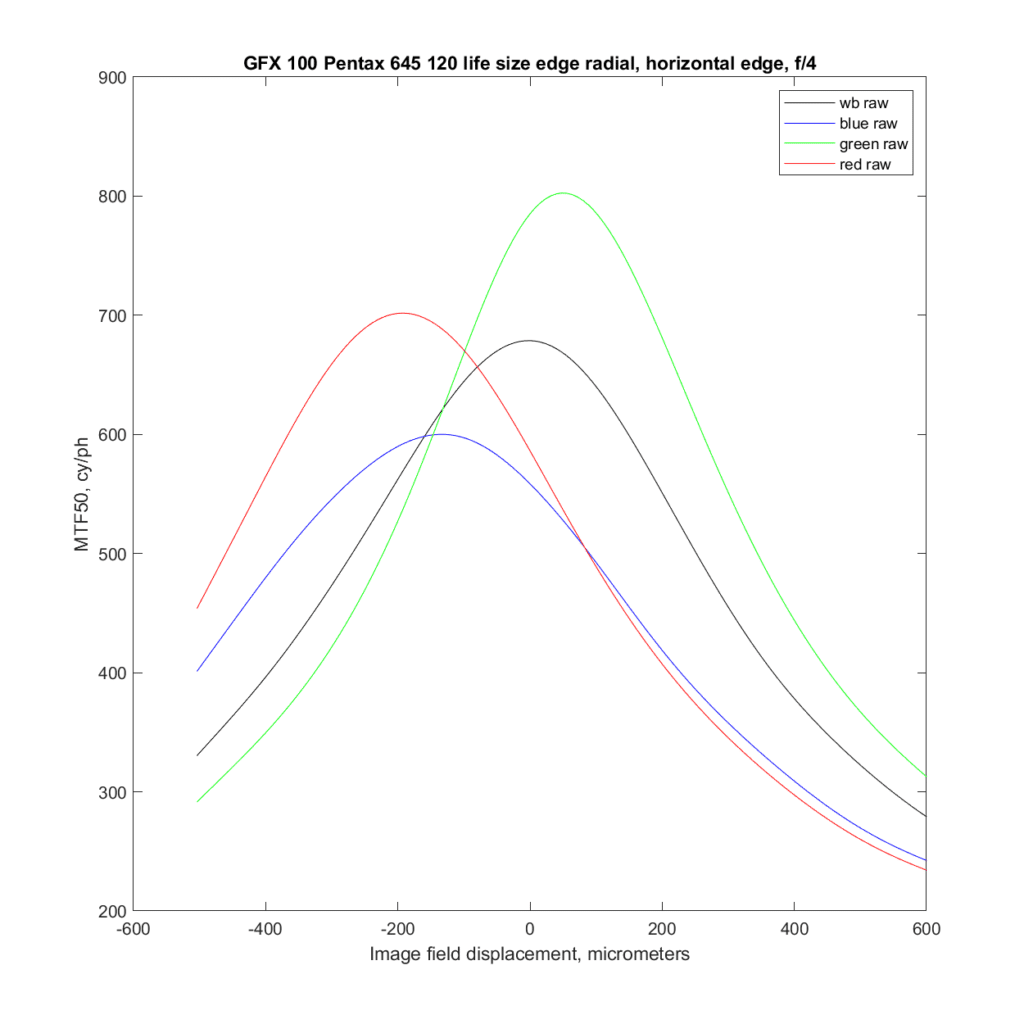
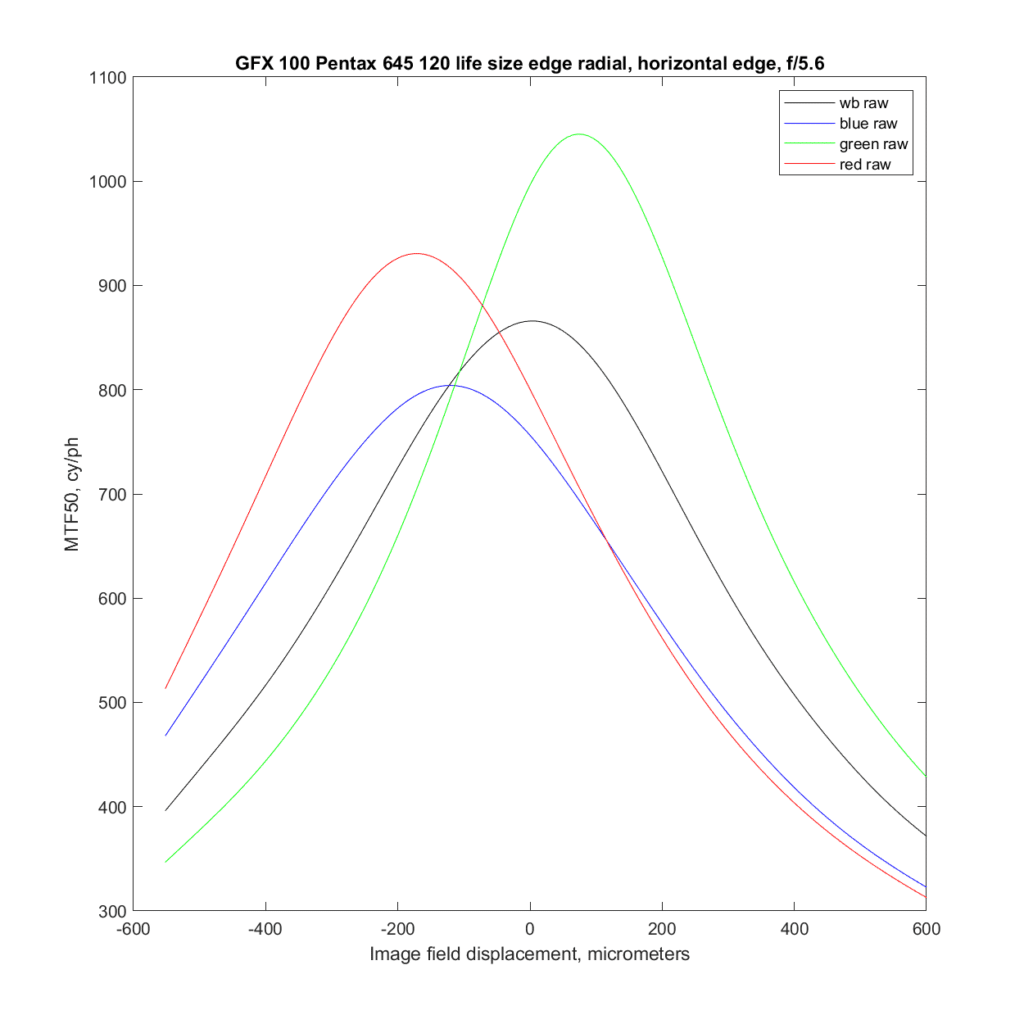
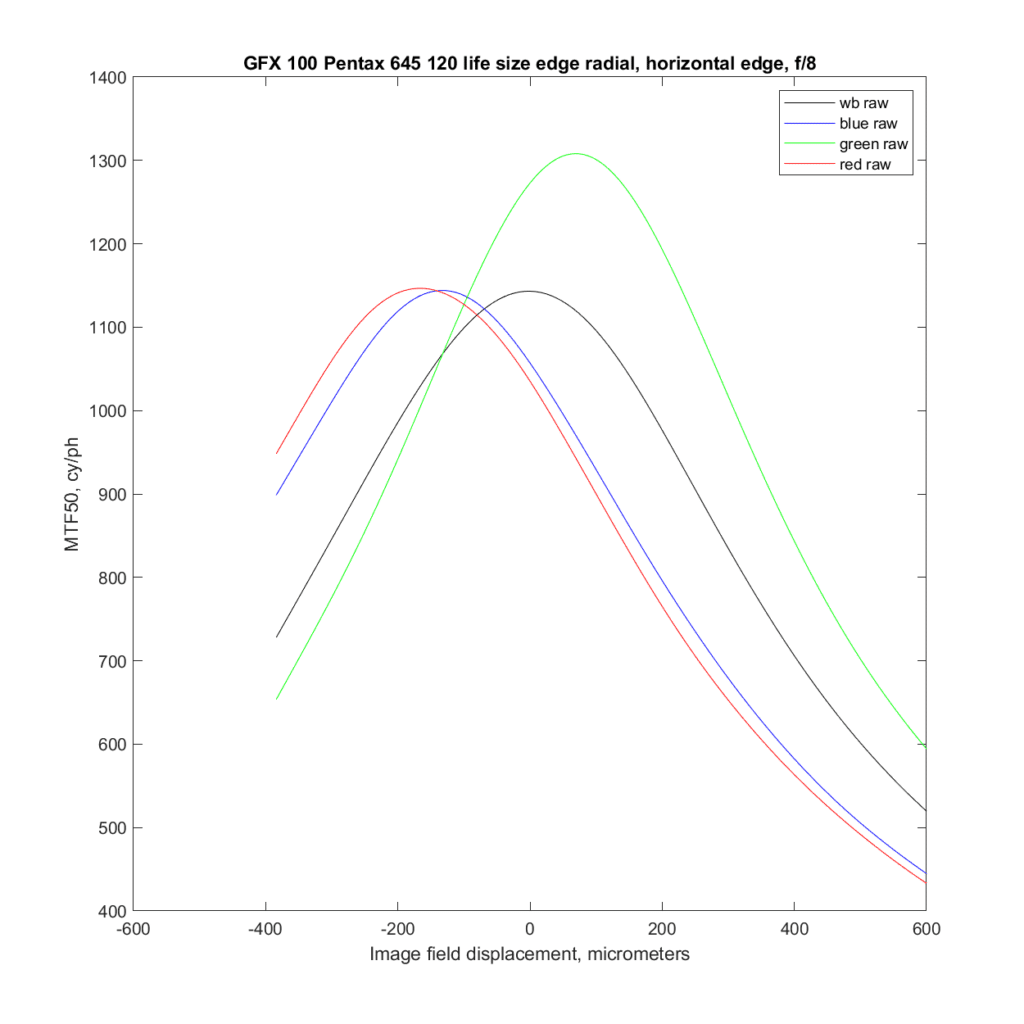
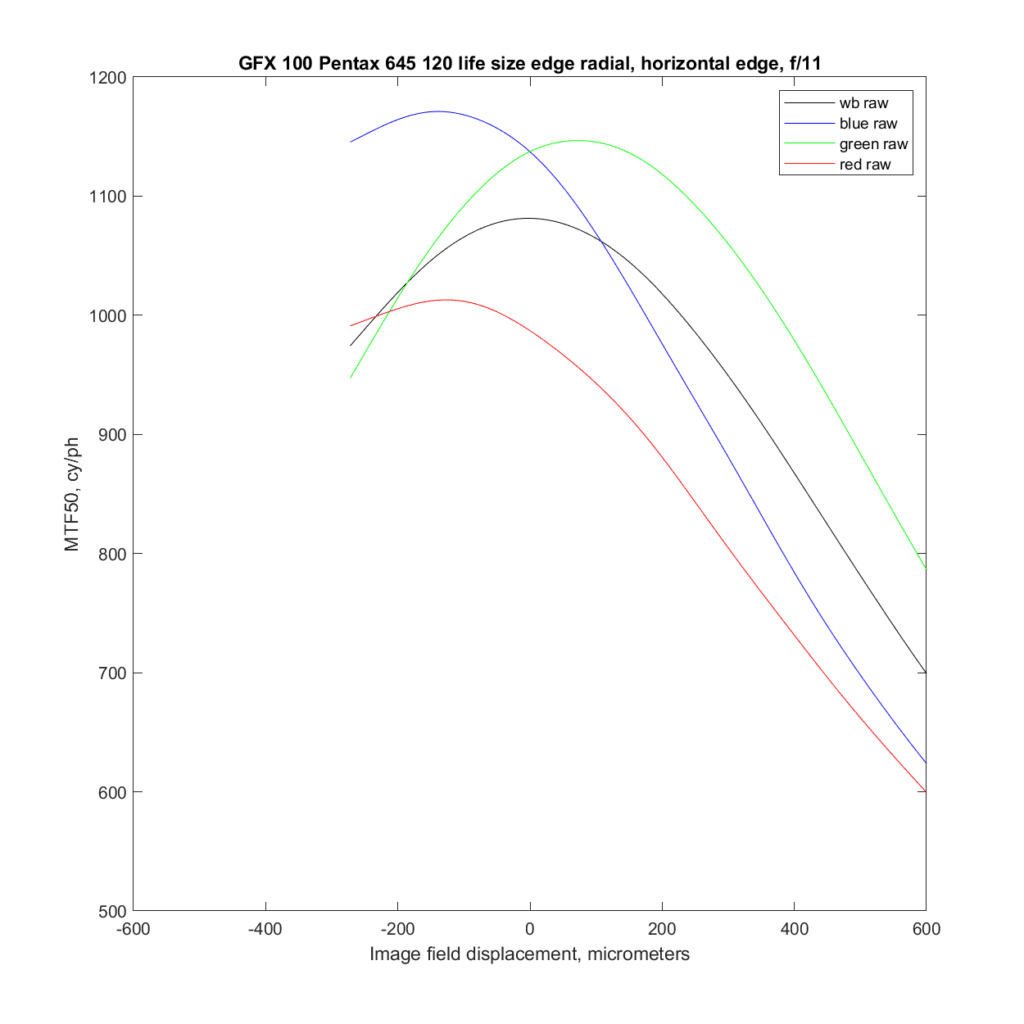
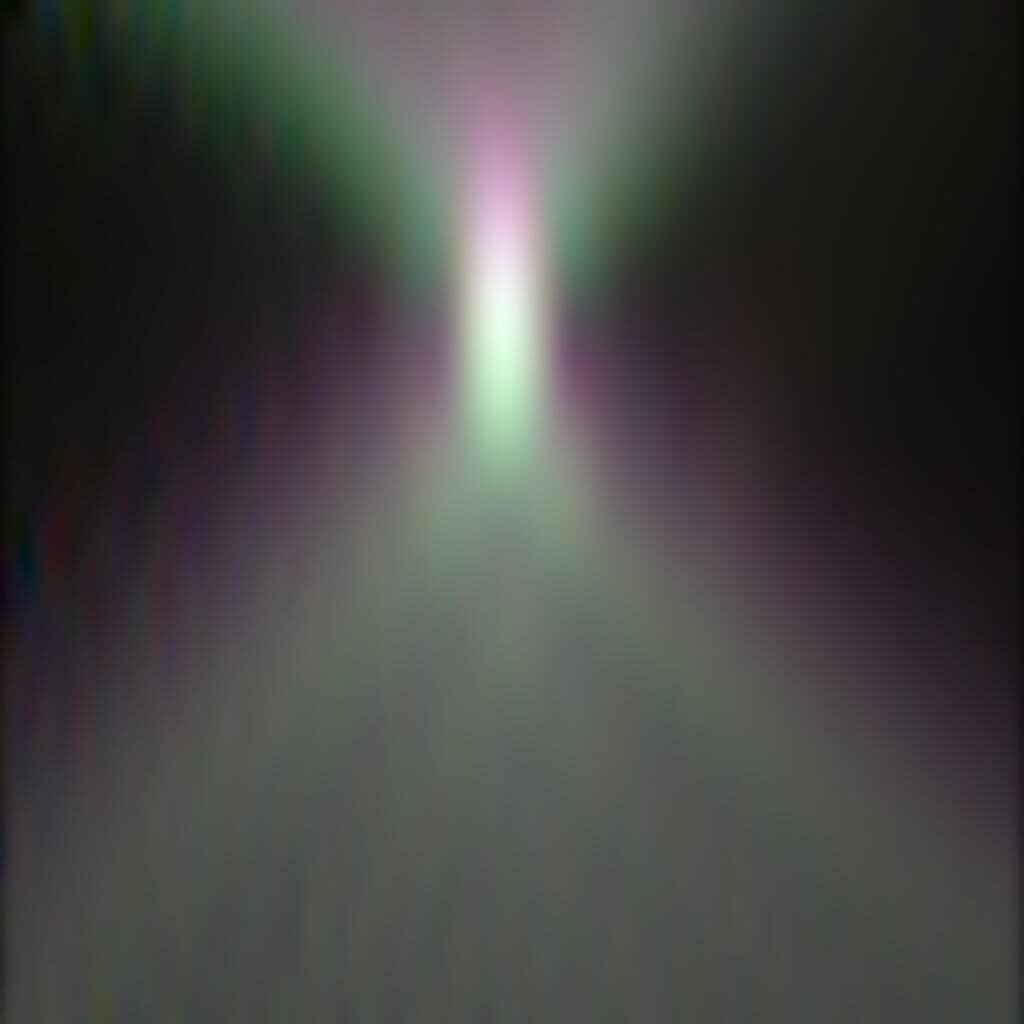
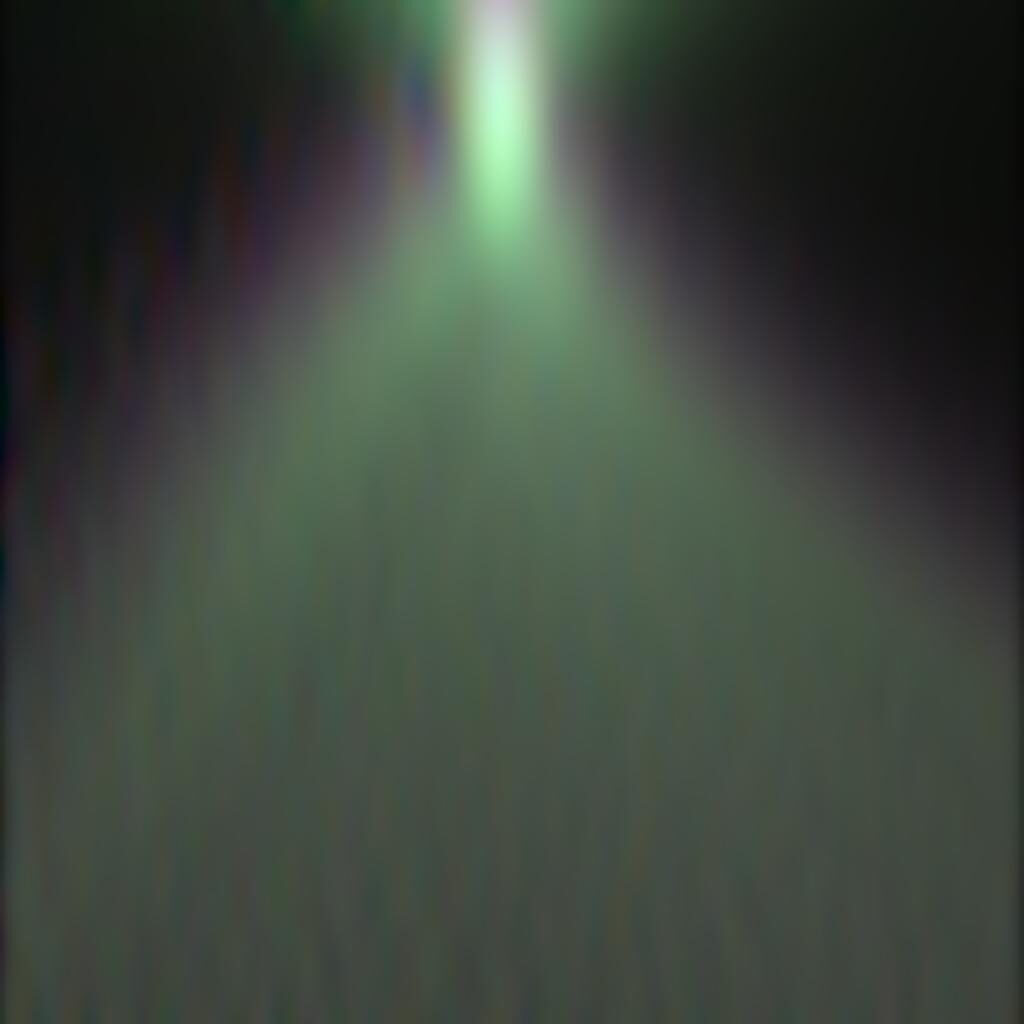
Can’t stop now, Mamiya 645 120 has to be next.
I have a Mamiya 645 120mm f/4 macro so I got a Pentax 645 120 to compare with it. Just did a quick macro test today, photographing a dollar bill with the Fujifilm GFX 50R AND 100s on a copy stand. The Mamiya is slightly better. The difference seems more apparent on my 50R photos than the 100S but I still give the Mamiya the nod. Plus, the adapter for the Mamiya does not require guessing at the aperture since there is no aperture control in the adapter. On the Mamiya, f/8 and f/11 were very close as the best. On the Pentax, I’m guessing somewhere between f/8 and f/11 since the adapter control was in the middle or close to it.
Did you test at 1:1?
I did not think of doing 1:1. I was not quite to 1:2 since my use for macro is scanning film and the magnification I used matched scanning a 6×4.5 frame. I’ll do another test later this week or the weekend with 1:1 and report back.
I performed tests today at 1:1, or as close as I could get using a copy stand without a macro rail for fine adjustment. Tested on both the Fujifilm 50R and 100S with a Mamiya 645 Macro A 120mm f/4 on a Kipon adapter and a Pentax 645 FA 120mm f/4 on a Fotodiox Pro adapter. The Mamiya was best at f/11 and the Pentax in the middle of the range (the Fotodiox adapter controls aperture so I don’t know what I am using). The Mamiya and Pentax are very close. I give the Mamiya a slight edge in the corners. If I had neither, I would recommend the Mamiya since it should cost less on the used market and you control aperture on the lens itself so you know what you are using.
Hello JIm,
Nearly all images on my website (www.brucejackson.com) were taken with a 4×5 field camera, utilizing Fuji Velvia. My main interest is creating images using tilt, shift, and swing on a digital camera system, the same as I do on my 4×5 field camera. Will the Cambo Actus with Fuji GFX 100s and modern Pentax 645 FA lenses provide equal to, or greater quality than my 4×5 Velvia image quality?
Or, is this simply not a good alternative solution to using 4×5 film?
Thank you for considering my questions.
Bruce Jackson
http://www.brucejackson.com
You’ll get far greater dynamic range. You’ll get far more accurate colors. You won’t get the same extinction resolution. Depending on your subjects, you may see aliasing.
I think the key question is: what’s your output medium?
If it’s looking at original chromes on a light table, stick with 4×5 Velvia.
Having read your reviews of the Pentax 120 and the Symmar 120 I gather the Symmar is the superior optic. Thank you for all the valuable information. I wonder how much better the Symmar is than the Pentax and if the extra fussing around with adapters and extension tubes negates any of that extra sharpness (e.g. by creating a less stable or harder to focus system). Thanks for any suggestions you may have, my goal is to set up a slide digitization workstation.
Done right, the adapting of the Symmar creates no stability issues. You may need to do some flocking to avoid flare.
I’m photographing 35mm and 120 negatives. I have a Fuji GFX 100ii and a 120 macro. Would you recomend that I buy the 45mm extension tube or buy a pentax 120mm with an adapter? Which do you think would be better for 1:1 on the negatives?
The Pentax 120 would be a better choice for that application.
Jim, I appreciate your tests and expertise. I’m in a similar situation as @Corey: have the 100s and 120 macro and the 18mm Fuji extension ring which gets me to just the right magnification to digitize 120mm film. Pretty satisfied with side and corner sharpness.
My question is about digitizing 35mm on GFX. Given that you need ~ 1.375X magnification (33mm/24mm) to capture 35mm on GFX MF, would using my setup of 120 with 18mm extension (~0.71X) and adding an excellent quality 72mm closeup screw in lens (3-4 diopter) get me decent quality vs buying a Pentax 120, adapter, and extension ring to fill the frame with 35mm? I’m reluctant to shell out another $700-1000 to do that vs just sticking with my current 45MP captures on Nikon z7 with 50mm S macro and ES-2 slide copier. Wondering if edge softness necessitates a crop of MF anyway and I barely beat the resolution of full frame Nikon Z7. Thanks for your advice.
Unless you’re stacking, you need a flat field. I doubt if you’ll get that with a diopter.
That’s what I feared, Jim. Thanks for your skepticism. I figured there was no free lunch with a cheaper solution.
Hey have you tested the new GF 110mm TS macro? I know it’s 1:2 max mag, but looking to scan 120 and 4×5 film using pixel shift multi shoot for 400mp scans of 4×5. I have a manual Pentax 645 120 macro and it’s good but could be sharper for this purpose with better CA control. How is the fuji 120 macro at these much smaller magnifications, are the edges better?
Sorry, but I haven’t tested the GF 110 T/S macro. The edges are good on the GF 120 macro at 1:2.